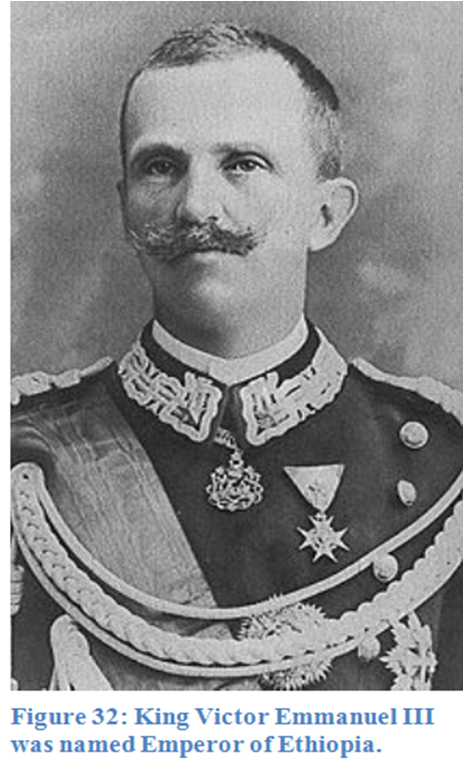Introduction
How the war Started
On 3rd October 1935 Italian forces invaded Ethiopia in what came to be famously known as the Italo-Ethiopian War. Emperor Haille Sellasie fled by train to Djibouti on 2nd May 1936 and later boarded a British battle ship to London.
 Addis Ababa (Ethiopia's Capital) fell on 5th May 1936 and thereafter Italy declared Ethiopian as a territory under the Kingship of victor Emmanuel of Italy. This was on 9th May 1936. In the meantime the Italian war machine was fully geared for a complete invasion of Ethiopia.
Addis Ababa (Ethiopia's Capital) fell on 5th May 1936 and thereafter Italy declared Ethiopian as a territory under the Kingship of victor Emmanuel of Italy. This was on 9th May 1936. In the meantime the Italian war machine was fully geared for a complete invasion of Ethiopia.
In the view of Pietro Badoglio, the Marshal of Italy who commanded the Italian forces of invasion, the objectives of the invasion were the utter destruction of the Abyssinian armed forces and the complete conquest of Ethiopia'.
 In October 1935, after inciting a number of local governors in Ethiopia to rise up Ethiopian chieftains preparing to fight the invading Italians against the rule of Haile Selassie, Italian forces began the invasion.
In October 1935, after inciting a number of local governors in Ethiopia to rise up Ethiopian chieftains preparing to fight the invading Italians against the rule of Haile Selassie, Italian forces began the invasion.
In a matter of seven months, Ethiopia was occupied and brutalities were committed. Most of the educated elite who were being raised by the Emperor were put to the sword; planes, batteries and poisonous gas were used to crush Ethiopian resistance.
On 9 May 1936 Italy formally announced the annexation of Ethiopia and King Victor Emmanuel of Italy was named Emperor of Ethiopia. Haile Selassie fled his country and lived in exile until 1941.
One important thing to note before concluding this chapter is that the League of Nations failed signally to fulfill its obligations by Ethiopia and thereby became discredited.
 Not long after the Italian occupation of Ethiopia member states began to recognise the new regime and the ineffectual economic sanctions that had been announced against Italy were removed. This was in spite of the prophetic speech made before the League in Geneva by Haile Selassie on 30 June 1936, in which he warned that if the League did not stand by its Charter, then 'the very existence' of the League was in danger.
Not long after the Italian occupation of Ethiopia member states began to recognise the new regime and the ineffectual economic sanctions that had been announced against Italy were removed. This was in spite of the prophetic speech made before the League in Geneva by Haile Selassie on 30 June 1936, in which he warned that if the League did not stand by its Charter, then 'the very existence' of the League was in danger.
He declared that what the League should settle was 'the confidence that each state is to place in international treaties . . . the value of promises made to small states, that their integrity and their independence be respected and ensured .
The Italians did not find their occupation of Ethiopia easy. Revolts against them were common and Italy's control was limited to the Ethiopia, showing the lines of the Italian invasion cities and villages where there were garrisons; there were many provinces over which the invaders had no control.
In 1937 an attempt was made on the life of the Italian viceroy. The Italians seized the occasion to put to death about 3,000 Ethiopians, mostly the educated, including over 100 priests.

Emperor Haille Sellasie: He fled by train to Djibouti on 2nd May 1936 and later boarded a British battle ship to London.
Another problem was that there were no resources in Italy to sustain the Italians' heavy expenditure on roads and public works. By 1940 the Italians had lost their firm control on Ethiopia. However this didn't mark the end of the trouble because Ethiopian commanders resorted to guerrilla warfare until 1941 when a combined force of Africans under the command of Britain defeated and drove the Italians out of Ethiopia.
The British action of fighting Italians in Ethiopian should not be confused to mean her love for the Ethiopians. Rather she was helping her self fight Italy which had joined Germany (Britain's enemy) during the 2nd World war.
Ethiopia, then, was a black feudalist state. But in spite of this, the Ethiopians' spirited and determined resistance to the Italian invasion inspired black men throughout the world, on the African continent and in the Black Diaspora in the Americas and the colonial metropolitan capitals, to adopt more militant and radical forms of black nationalist resistance to white colonialism.
National Movements and New States in Africa